Ask Ethan #75: How can we still see the Big Bang?
If it happened billions of years ago, what’s it still doing here?
“We like to admit to only that which already glows, although it is nobler to support brightness before it glows, not afterwards.” –Dejan Stojanovic
Sometimes, the simplest questions make for the most profound answers, and give us the opportunity to really dig deep into how we view the fabric of the Universe itself. This week, after sifting through your questions and suggestions for our Ask Ethan column, I couldn’t pass up the spectacular but straightforward question of Joseph McFarland, who wants to know:
Why do we continue to detect the cosmic background radiation?
Is the fact that we continue to eternally see the cosmic background radiation billions of years after it was generated proof of either inflation, or that the universe must be curved back upon itself (i.e. that it is finite but unbounded)?
Or if neither of these are requirements, then what are other explanations?
I want you to think about the history of the Universe.
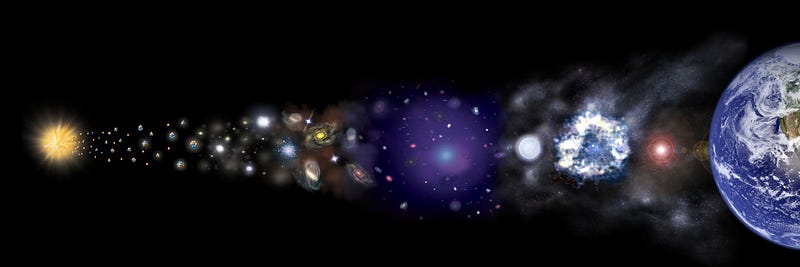
In particular, I want you to think of why it’s such a remarkable thing that we do detect the Cosmic Microwave Background at all. The story starts at the moment of the Big Bang, or more specifically, at the hot Big Bang.

The hot Big Bang refers to a time some 13.8 billion years ago, when the Universe first emerged from an inflationary state — one where all the energy in it was inherent to space itself — and got converted into matter, antimatter and radiation. We can think of this as inflation being a field that’s in an unstable state, like a ball at the top of a hill, that then rolls down that hill and into a valley.
While the ball is at the top of the hill, space itself expands at an exponential rate. When the ball rolls into the valley, and starts oscillating back-and-forth, that energy-of-space gets converted into matter, antimatter and radiation: a process known as reheating.
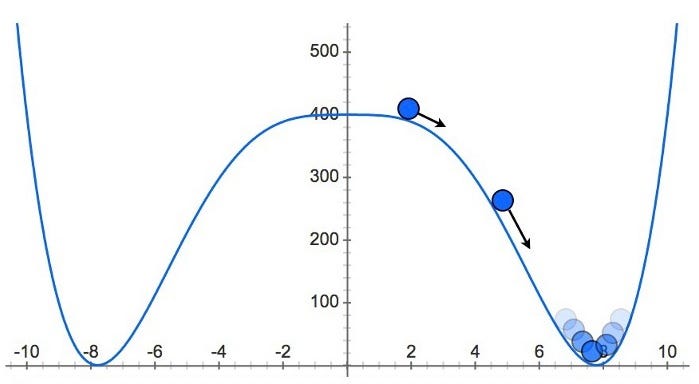
The Universe still continues to expand, but because it’s filled with matter, antimatter and radiation, it no longer maintains a very large expansion rate for long. The expansion rate is tied — in General Relativity — to the energy density of the Universe, or how much energy there is per-unit-volume.
When all you had was energy inherent to space itself, as the Universe expanded, you simply made more empty space, and the energy density stayed the same. But now that you’ve got stuff in the Universe instead, it dilutes (and gets less dense) as the Universe expands. In the case of radiation, the wavelength of light also stretches, which is why the Universe not only gets less dense, it also cools as time goes on.

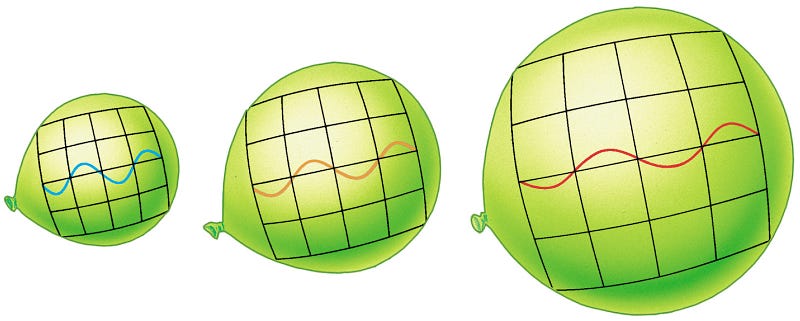
As the Universe expands and cools, from an incredibly hot, dense, uniform, rapidly expanding state down to a cool, sparse, clumpy, slowly expanding state, a huge number of important events happen:
- The fundamental symmetries of nature that are restored at the highest energies become broken, giving rise to things like particle rest masses.
- The Universe gets cool enough so that photons stop spontaneously forming matter/antimatter pairs. The excess antimatter annihilates away, leaving only 1 matter particle per ~1,400,000,000 photons.
- The interaction strength and rate drops significantly enough that neutrinos stop interacting with everything else in the Universe.
- The photon temperature drops enough so that the first stable, atomic nuclei can form without immediately being blasted apart.
- The temperature drops even further — by about another factor of a million — so that neutral atoms can stably form.
- And after that, the overdense regions grow into stars, galaxies and clusters of galaxies, giving rise to the Universe we see today, all while the photon energy continues to drop thanks to the ongoing expansion.
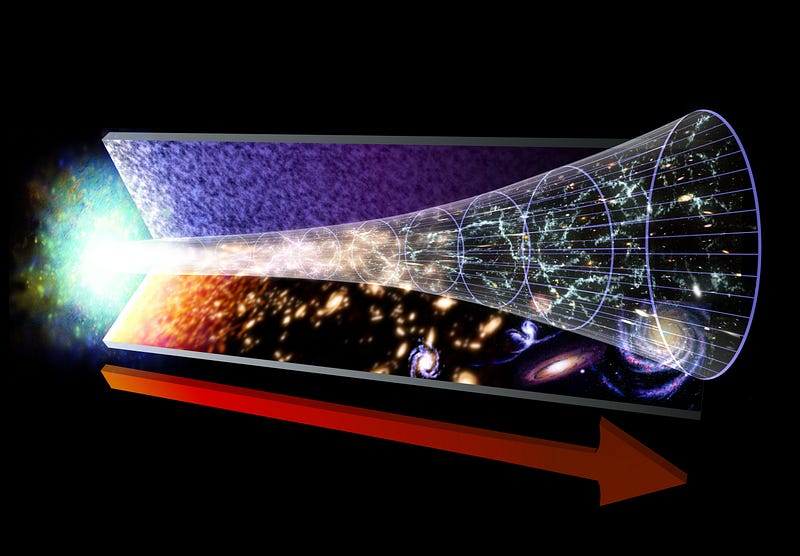
That next-to-last step — the one about the atoms becoming neutral — is where the Cosmic Microwave Background (CMB) originates. Prior to that time, the atoms were all ionized, meaning that they were simply positively charged nuclei and free electrons, bathed in a sea of photons. But photons have an extremely large scattering cross-section with electrons, meaning that they bounced around a tremendous amount.
It’s only when the Universe cooled enough to become neutral that photons stopped seeing free electrons and started seeing only neutral, stable atoms. Because neutral atoms only absorb photons at very particular frequencies, and most of the photons that exist are not at those frequencies, these atoms are effectively transparent to all the photons that exist in the Universe!

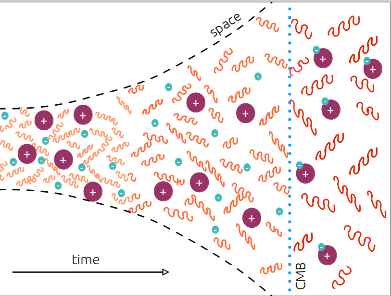
But because the Universe has been expanding and cooling for so long, you can take our location in space and fix it, and recognize one disconcerting fact: all the light from the Big Bang in the regions surrounding our own has been passing us by, continuously, for 13.8 billion years.
All the stars, galaxies, large-scale structure, gas clouds and cosmic voids located thousands, millions, billions or even tens of billions of light-years away saw their CMB light pass us by ages and ages ago.
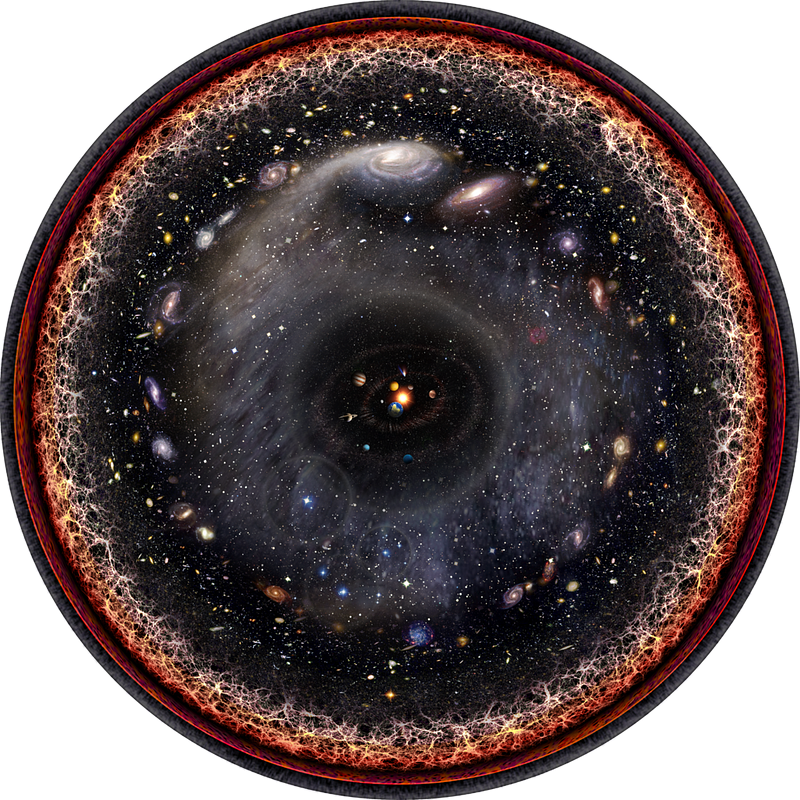
Yet — to the point of Joseph’s original question — we still see the CMB, which corresponds (today) to a surface that’s some 45.3 billion light-years away.
The fact that we still see the CMB at all tells us something very important: the Big Bang happened everywhere at once in a region of space that’s at least 45.3 billion light-years in radius, as seen from our perspective.

And the fact that the CMB is not only visible in all directions, but is of a uniform temperature in all directions tells us — in the context of an inflationary Universe — that the amount that the (observable) Universe inflated must have taken it from an initial size that was, at maximum, 10^-29 meters (or less than a trillionth of 1% the size of a proton) and grew it by at least a factor of 10,000,000,000,000,000,000,000.
The part of the Universe that we see, today, as our observable Universe could have been even smaller than that scale of 10^-29 meters, initially, and the amount that inflation grew that initial patch of space could have been arbitrarily larger than the factor of 10^22; there is no upper limit on that.

So when we look at the Cosmic Microwave Background, at its uniformity and its small-scale, low-magnitude fluctuations, and the fact that there are no regions of it that are identifiable with one another (i.e., that the Universe does not exhibit a closed topology), we can conclude from this alone that the Big Bang must have occurred everywhere at once in a large region as viewed from our perspective.
In the context of inflation — something we know an awful lot about — this gives us a lower bound as to the duration and scope of inflation, and ties it in to our observable Universe. The reason the CMB is still around is because the Big Bang, which itself came about at the end of inflation, happened over an incredibly large region of space, a region that’s at least as large as where we observe the CMB to still be. In all probability, that true region is much larger, and that not only will observers anywhere in the Universe see roughly the same CMB, but that we’ll continue to see it (albeit, redshifted a little farther) arbitrarily far into the future.
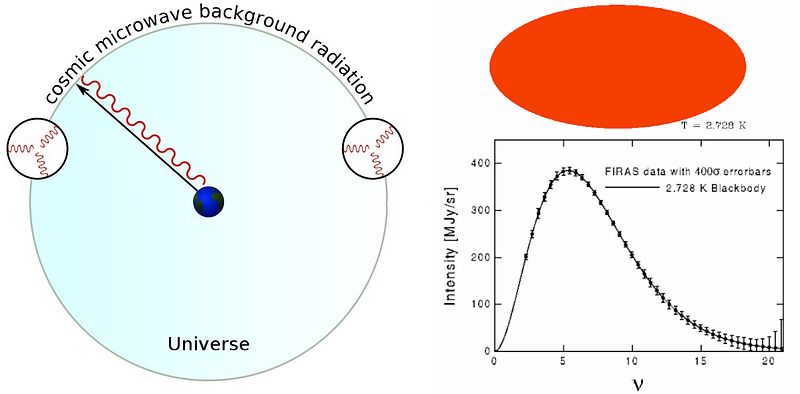
Thanks for a great question, Joseph, and thanks to all of you for sending in a great selection of questions and suggestions for Ask Ethan! The truths of the Universe are written on the face of the Universe itself, and we’re doing everything we can to uncover them!
Leave your comments at the Starts With A Bang forum on Scienceblogs!




